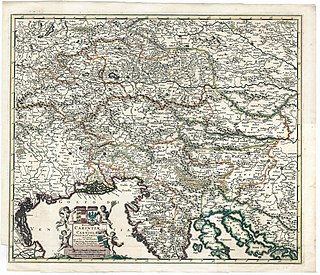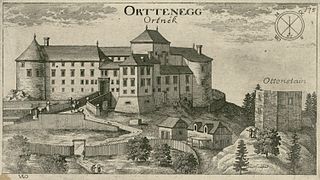Slovene peasant revolt may refer to:
Slovene peasant revolt may refer to:

The history of Slovenia chronicles the period of the Slovenian territory from the 5th century BC to the present. In the Early Bronze Age, Proto-Illyrian tribes settled an area stretching from present-day Albania to the city of Trieste. The Slovenian territory was part of the Roman Empire, and it was devastated by the Migration Period's incursions during late Antiquity and the Early Middle Ages. The main route from the Pannonian plain to Italy ran through present-day Slovenia. Alpine Slavs, ancestors of modern-day Slovenians, settled the area in the late 6th Century AD. The Holy Roman Empire controlled the land for nearly 1,000 years, and between the mid-14th century and 1918 most of Slovenia was under Habsburg rule. In 1918, Slovenes formed Yugoslavia along with Serbs and Croats, while a minority came under Italy. The state of Slovenia was created in 1945 as part of federal Yugoslavia. Slovenia gained its independence from Yugoslavia in June 1991, and is today a member of the European Union and NATO.

Slovene, or alternatively Slovenian, is a South Slavic language, a sub-branch that is part of the Balto-Slavic branch of the Indo-European language family. It is spoken by about 2.5 million speakers worldwide, mainly ethnic Slovenes, the majority of whom live in Slovenia, where it is the sole official language. As Slovenia is part of the European Union, Slovene is also one of its 24 official and working languages.

The Slovene peasant revolt, also known as the All-Slovene Peasant Uprising, took place in 1515 and was the largest peasant revolt in the Slovene Lands. It engulfed most of what is now Slovenia as well as a significant portion of the province of Carinthia, which today is a part of Austria. There were about 80,000 rebels who demanded the reintroduction of the original feudal obligations and trade rights and a right to decide about the taxes. The spark which started this uprising was when the ethnic German peasants of the Gottschee region killed their lord Jorg von Thurn. They attacked the castles within the region, except in the territory of the County of Görz, where conflicts were solved through negotiations. The revolt was put down by the mercenaries of the Holy Roman Empire, with the deciding battle fought at Celje. The words stara pravda were printed in 1515 in Vienna in a poem of the German mercenaries and were the first printed Slovene words.

The Croatian–Slovene Peasant Revolt, Gubec's Rebellion or Gubec's peasant uprising of 1573 was a large peasant revolt on territory forming modern-day Croatia and Slovenia. The revolt, sparked by cruel treatment of serfs by Baron Ferenc Tahy, ended after 12 days with the defeat of the rebels and bloody retribution by the nobility.

Brežice is a town in eastern Slovenia in the Lower Sava Valley, near the Croatian border. It is the seat of the Municipality of Brežice. It lies in the center of the Brežice Plain, which is part of the larger Krka Flat. The area was traditionally divided between Lower Styria and Lower Carniola. The entire municipality is now included in the Lower Sava Statistical Region.

Matija Gubec, also known as Ambroz Gubec, was a Croatian revolutionary, and a leader of the Croatian–Slovene Peasant Revolt of 1573. He was part of the court of three people that governed the rebels.

King Matjaž/Mátyás/Matijaš is a legendary king in Slovenia, Hungary, Croatia and in some other countries, based on pre-Christian traditions of Carantania and in course of centuries gradually linked to a real-life king, Matthias Corvinus of Hungary, who lived in the second half of the 15th century. He has also been linked to the leader of the peasant's army that fought against the Turks in the Battle of Kokovo in July 1478. A number of folk poems and stories about King Matjaž are known, the earliest ones originating in the western Slovene area of Tolmin from the 16th century. He is mainly represented as the king who is just and a defender of his people, and the bringer of the golden age of prosperity. It has been assumed that the legend was the basis for the name of the 1573 peasants' revolt leader Matija Gubec, actually named Ambrož Gubec.

Brežice Castle is a 16th-century castle in the town of Brežice, in southeastern Slovenia, at the street address Cesta prvih borcev 1.

St. James's Bridge in Ljubljana is a bridge that crosses the Ljubljanica River on the southern end of downtown Ljubljana, next to Zois Manor. It links Zois Street and Karlovac Street. The most important city traffic artery across the Ljubljanica runs across it.

Stojan Batič was a Slovene sculptor. Mostly a figurative artist, he is particularly known for his sculptures exhibited in many public places in Slovenia.

Ortnek Castle is a 12th-century castle ruin in the vicinity of the town of Ribnica, Slovenia. The ruin stands on Big Žrnovec Hill, near the village of Hudi Konec.

Ig Castle, also Sonnegg Castle or Zonek Castle, stands on Pungart Hill above the settlement of Ig, on the southern outskirts of Ljubljana, the capital of Slovenia.

Raka is a village in the Municipality of Krško in eastern Slovenia. The area is part of the traditional region of Lower Carniola. It is now included with the rest of the municipality in the Lower Sava Statistical Region. The village is known for a quality variety of onion.
Reštanj is a dispersed settlement in the hills north of Senovo in the Municipality of Krško in eastern Slovenia. The area is part of the traditional region of Styria. It is now included in the Lower Sava Statistical Region.

The Carinthian Peasant Revolt took place in the Duchy of Carinthia in 1478. It was the first of several larger peasant revolts in the area of Inner Austria. After several Ottoman raids from 1473 onwards, the rural population established a peasants' association that was an effort to take the defence of the farmers' homes into their own hands and was also aimed against the ruling nobility that had failed to protect the farmers from attacks by marauding Turkish akinji cavalry. The revolt was eventually suppressed.

Ive Šubic was a Slovene painter, graphic artists and illustrator.

The German Peasants' War, Great Peasants' War or Great Peasants' Revolt was a widespread popular revolt in some German-speaking areas in Central Europe from 1524 to 1525. It was Europe's largest and most widespread popular uprising before the French Revolution of 1789. The revolt failed because of intense opposition from the aristocracy, who slaughtered up to 100,000 of the 300,000 poorly armed peasants and farmers. The survivors were fined and achieved few, if any, of their goals. Like the preceding Bundschuh movement and the Hussite Wars, the war consisted of a series of both economic and religious revolts involving peasants and farmers, sometimes supported by radical clergy like Thomas Müntzer. The fighting was at its height in the middle of 1525.

Ferenc Tahy de Tahvár et Tarkő, was a Hungarian–Croatian nobleman from the Tahy family, which draws its origins from Pilis County. He was known to have held the positions of royal adviser and master of the horse. His cruel treatment of serfs was one of the causes of Croatian–Slovene Peasant Revolt.